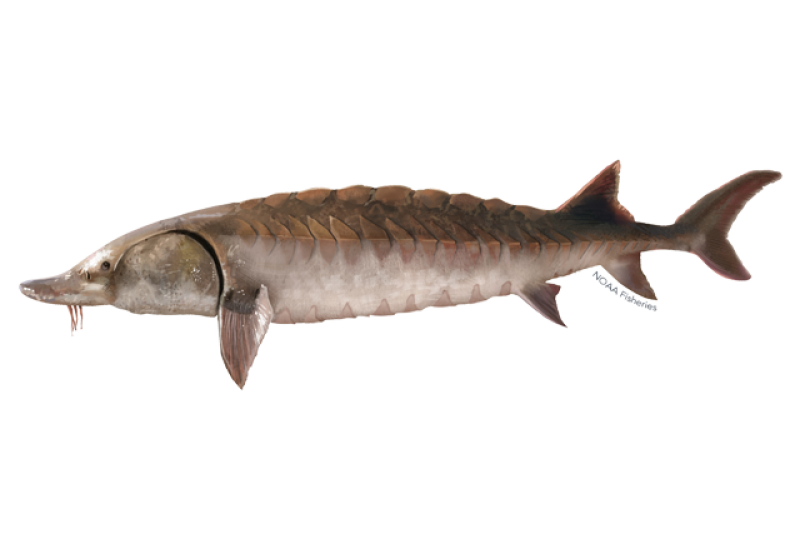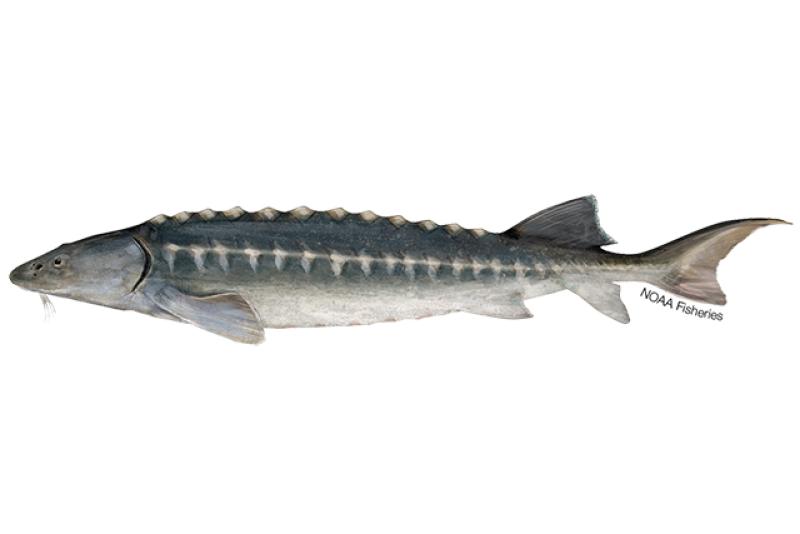Green Sturgeon
Acipenser medirostris

Protected Status
Quick Facts
 Adult green sturgeon in Klamath River, CA. Credit: Thomas Dunklin
Adult green sturgeon in Klamath River, CA. Credit: Thomas Dunklin
Adult green sturgeon in Klamath River, CA. Credit: Thomas Dunklin
About the Species
 Adult green sturgeon in Klamath River, CA. Credit: Thomas Dunklin
Adult green sturgeon in Klamath River, CA. Credit: Thomas Dunklin
Adult green sturgeon in Klamath River, CA. Credit: Thomas Dunklin
Green sturgeon are an anadromous fish, which means they can live in both fresh and saltwater. They have a relatively complex life history that includes spawning and juvenile rearing in rivers followed by migrating to saltwater to feed, grow, and mature before returning to freshwater to spawn. They are a long-lived, slow-growing fish. They are vulnerable to many stressors and threats including blocked access to spawning grounds and habitat degradation caused by dams and culverts. The southern distinct population segment is listed as threatened under the Endangered Species Act.
NOAA Fisheries is committed to conserving and protecting green sturgeon. Our scientists and partners use a variety of innovative techniques to study, learn more about, and protect this species.
Brochure on the life cycle, key threats, recovery actions, and success stories of Green Sturgeon
Population Status
Twenty-seven species of sturgeon can be found in temperate waters of the Northern Hemisphere. Two of them reside on the West Coast of North America: the green sturgeon (Acipenser medirostris) and the white sturgeon (Acipenser transmontanus).
NOAA Fisheries received a petition in June 2001 from several environmental organizations requesting that the agency list the North American green sturgeon under the Endangered Species Act. On April 7, 2006, we listed the southern distinct population segment, or sDPS, of North American green sturgeon as threatened under the ESA. Critical habitat was designated on October 9, 2009. On June 2, 2010, NOAA Fisheries published a final ESA 4(d) rule to establish protective regulations for the southern distinct population segment of North American green sturgeon. We released a final environmental assessment analyzing the environmental impacts of the ESA Section 4(d) rule.
Behavior and Diet
Sturgeon are most closely related to paddlefish, reedfish, and numerous fossil groups within the infraclass Chondostei. These are primary cartilaginous fish with some degree of bony structures (ossification). They are not ancestral to modern bony fish but represent a highly specialized and successful offshoot of ancestral Chondosteans. Their skeletons are composed of cartilage, and they have a series of external bony plates called scutes along their backs and sides.
Sturgeon are often likened to sharks because of the many features they share, including:
- Spiracles
- Heterocercal tails
- Fin and jaw structure
- Spiral valve
- Ampullae of Lorenzini (special sensing organs forming a network of jelly-filled pores). These unique sensory organs allow them to detect electrical signals given off by prey in murky waters and substrates.
Sturgeon do not have teeth. Instead, they use their long, flexible "lips" (i.e., protrusible jaw) to suck up food from the bottom.
Green sturgeon identification guide and guidance for catch and release (PDF, 1 page)
Green sturgeon were first described in San Francisco Bay in 1857. They are anadromous but spend more time in the ocean than most sturgeon species. They can be found from Alaska to Mexico but are most commonly encountered north of Point Conception, California. They differ from white sturgeon in their olive green coloration, barbell placement, vent placement, differences in number and sharpness of scutes, and presence of an additional scute behind the dorsal and anal fins.
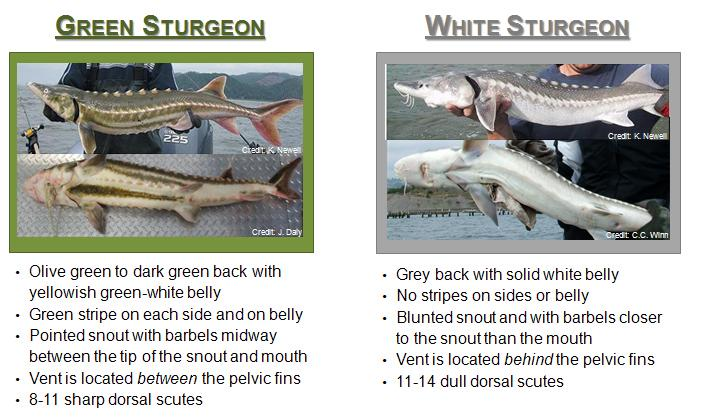
Lifespan & Reproduction
Green sturgeon reach maturity around age 15 and can live to be 60 to 70 years old. Unlike salmon, they may spawn several times during their long lives, returning to their natal rivers every 3 to 5 years. By comparing the DNA and movement patterns of tagged fish, researchers identified two genetically distinct population segments of green sturgeon. Although these fish may look identical, their genetic makeup is different. This distinction allows NOAA Fisheries and other agencies to manage populations more effectively and helps preserve diversity.
Fish that spawn in the Klamath and Eel River in Northern California and the Rogue River in Oregon belong to the Northern DPS (nDPS). Fish that spawn in the Sacramento, Feather, and Yuba River in California belong to the federally threatened southern DPS (sDPS).
During spawning runs, adult sDPS fish enter San Francisco Bay between mid-February and early May and migrate rapidly up the Sacramento River. Spawning occurs in cool sections of the upper Sacramento River where there are deep, turbulent flows and clean, hard substrate. In the autumn, these post-spawn adults move back down the river and re-enter the ocean. After hatching, larvae and juveniles migrate downstream toward the Sacramento-San Joaquin Delta and estuary. After rearing in the delta and estuary for a few years, they move out to the ocean. As adults, both population segments of green sturgeon migrate seasonally along the West Coast. They congregate in bays and estuaries in Washington, Oregon, and California during the summer and fall months. During winter and spring months they congregate off of the northern Vancouver Island in British Columbia, Canada.
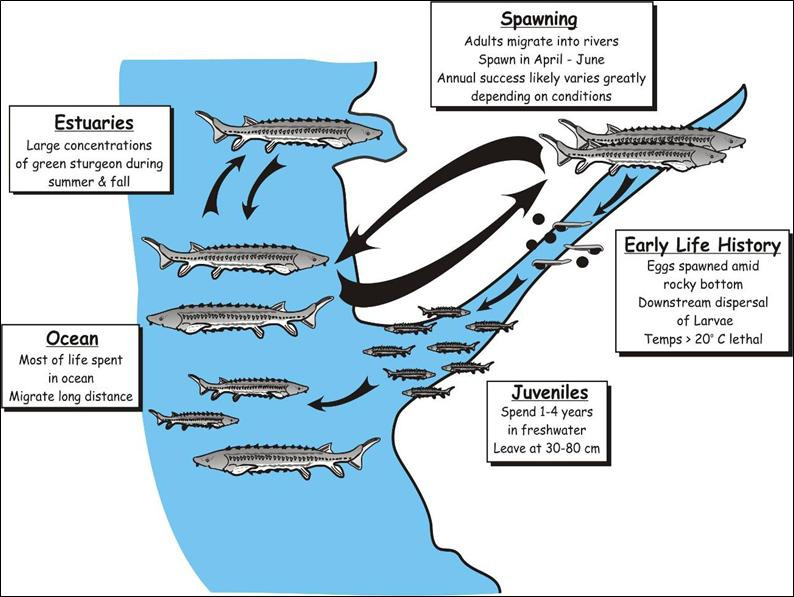
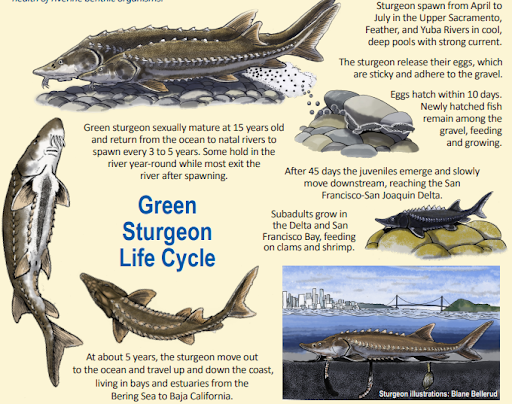
Threats
Green sturgeon populations successfully persisted throughout North America for 200 million years. They are thought to have experienced a precipitous decline in abundance during the past century, which is likely a result of anthropogenic harvest and destruction of spawning and rearing habitat. There are now regulations in effect prohibiting harvest , but the most significant threats to green sturgeon likely relate to the ongoing loss and inaccessibility of available spawning habitat. Much of this is driven by competing water resource needs between humans and fish.
Dams and other impassible barriers, altered flows, and entrapment in water diversions can impede or inhibit their migration. Other threats to the survival and recovery of this ancient fish include:
- Insufficient freshwater flow rates in spawning areas
- Contaminants
- Fisheries bycatch
- Poaching
- Invasive species
- Unfavorable water conditions
Improved Passage and Barrier Removal
An important step in barrier removal was the decommissioning of the Red Bluff Diversion Dam (rkm 391 on the Sacramento River) in 2013. With the permanent raising of the Dam’s gates, upstream spawning grounds became accessible for adult sDPS green sturgeon. Larvae and juvenile sDPS green sturgeon have been collected by USFWS in Red Bluff every year since the dam was decommissioned, and spawning has since been observed both upstream and downstream of the decommissioned dam, indicating sturgeon are using this previously unattainable spawning habitat.
In 2019, the California Department of Water Resources (DWR) improved fish passage for salmonids and sturgeon entering the Yolo Bypass from the Sacramento and Feather rivers. The improved Fremont Weir fish passage facility allows for the volitional passage of adult sturgeon onto the Yolo Bypass during weir overtopping events. California DWR is continuing to improve fish passage and increase floodplain rearing habitat in the Yolo Bypass.
View the Fremont Weir Adult Fish Passage Project video on YouTube
Scientific Classification
| Kingdom | Animalia | Phylum | Chordata | Class | Osteichthyes | Order | Acipenseriformes | Family | Acipenseridae | Genus | Acipenser | Species | medirostris |
|---|
Last updated by NOAA Fisheries on 06/23/2025
How You Can Help
Know the Law Before You Fish
It is illegal to fish for, catch, or keep green sturgeon. If you accidently hook a green sturgeon be prepared to catch and release with care.
Report a Dead Sturgeon
If you find a sturgeon carcass, please send us an email at CASturgeon.Research@noaa.gov. Photos are very helpful and can be used to identify sturgeon species.
Report a Violation
Call the NOAA Fisheries Enforcement Hotline at (800) 853-1964 to report a federal marine resource violation. This hotline is available 24 hours a day, 7 days a week for anyone in the United States.
You may also contact your closest NOAA Office of Law Enforcement field office during regular business hours.
Learn About Bycatch
One of the main threats to marine animals is entanglement in fishing gear, especially gillnets. Fishermen sometimes catch and discard animals they do not want, cannot sell, or are not allowed to keep. This is collectively known as bycatch.
Featured News
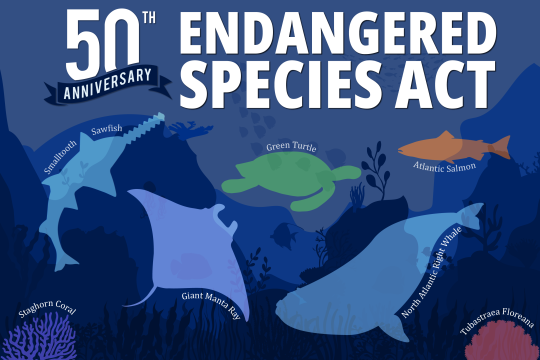
The Endangered Species Act: 50 Years of Conserving Species
 Adult green sturgeon in Klamath River, CA. Credit: Thomas Dunklin
Adult green sturgeon in Klamath River, CA. Credit: Thomas Dunklin
Management Overview
The green sturgeon southern distinct population segment (DPS) is listed as threatened under the Endangered Species Act.
Additionally, the green sturgeon is listed under:
- Appendix II of the Convention on International Trade in Endangered Species of Wild Fauna and Flora (CITES)
Recovery Planning and Implementation
Green sturgeon recovery depends on the commitment to a sound ecosystem conservation plan.
Critical Habitat
On October 9, 2009, NOAA Fisheries designated final critical habitat for North American green sturgeon sDPS.
In freshwater, the designated critical habitats are:
- Mainstem Sacramento River downstream of Keswick Dam (including the Yolo and Sutter bypasses)
- Feather River below Oroville Dam
- Yuba River below Daguerre Point Dam
- Sacramento-San Joaquin Delta
In marine waters, the designated critical habitats are:
- Areas within the 60 fathom (110 meter) depth isobath from Monterey Bay to the U.S.-Canada border
In coastal bays and estuaries, the designated critical habitats are:
- San Francisco Bay Estuary and Humboldt Bay in California
- Coos, Winchester, Yaquina, and Nehalem bays in Oregon
- Willapa Bay and Grays Harbor in Washington
- Lower Columbia River Estuary from the mouth to rkm 74
Learn more about the green sturgeon critical habitat designation
ESA Listing, Status Review, and Protection Regulations
- ESA Listing Rule (April 7, 2006)
- Green sturgeon status reviews and updates
- ESA 4d Rule (Protective Regulations) (June 2, 2010)
Regulatory History
Regulations prohibit the retention of green sturgeon in both recreational and commercial fisheries throughout California, Oregon, Washington, and British Columbia. These regulations significantly reduce the risk of loss of green sturgeon to fishing activities and are expected to have a substantial conservation impact.
Recent research efforts have focused on monitoring early life history stages and estimating adult abundance to better evaluate overall species status. We are also seeking increased understanding of the impacts of contaminant exposure, ocean energy projects, predation by native and non-native species, foraging and feeding behavior, and baseline population data.
In addition to enforcing fishing regulations and supporting new research, we work to manage and recover sDPS North American Green Sturgeon by working collaboratively with our many partners to ensure sufficient water flow and manage temperatures, limit the input of contaminants, deter poaching, and restore habitat.
Key Actions and Documents
More Information
Last updated by NOAA Fisheries on 06/23/2025
Science Overview
NOAA Fisheries and our many partners are currently continuing numerous studies of the distribution, migrations, spawning habitat utilization, and population genetics of green sturgeon both in collaborative and independent efforts. These partners include:
- U.S. Fish and Wildlife Service
- University of California at Davis
- California Department of Fish and Wildlife
- Oregon Department of Fish and Wildlife
- Washington Department of Fish and Wildlife
- CalFish Track
Green Sturgeon Bycatch Project
Green Sturgeon Post-Release Impacts in West Coast Trawl Fisheries
The threatened sDPS North American Green Sturgeon are sometimes caught accidentally in fisheries along the West Coast, including the California halibut bottom trawl fishery. This is known as bycatch. The impact to the species is difficult to understand given the lack of information on the effects of catch and release on green sturgeon in these fisheries.
To address this question, NOAA Fisheries is partnering with stakeholders to evaluate the survival rate of green sturgeon incidentally caught in the California halibut fishery and then released alive. We applied satellite tags to green sturgeon caught incidentally in the California halibut bottom trawl fishery to track the post-release movements and survival of the fish. We are also deploying cameras on the trawl nets to see how fish get caught in the net. This will inform development of methods to reduce bycatch. The goals of this study are to understand green sturgeon post-release impacts, provide further insights on green sturgeon movements, and strengthen NOAA’s relationship with fishermen.
Project partners:
- California Halibut Fishery
- California Department of Fish and Wildlife
- NOAA Observer Program
- NOAA Northwest Fisheries Science Center (NWFSC)
- NOAA Southwest Fisheries Science Center (SWFSC)
- UC Davis
Project History and Timeline
- 2018 - 2021: Developed and implemented pilot study to deploy cameras on trawl nets to evaluate fish-gear interactions. Funding was obtained from the SWFSC Cooperative Research Program.
- 2017 and 2018: Analyzed tag data and developed manuscript.
- 2015 and 2016: Implemented research strategy in the field in partnership with fishermen and observers.
- 2014: Received additional funding from the SWFSC Cooperative Research program and NOAA Fisheries West Coast Region Protected Resources Division to launch the project, including funds for equipment/supplies, contracts, and a rewards program.
- August 2013: Convened workshop with stakeholders to discuss the issue and develop a cooperative research strategy. Funding was obtained from the SWFSC Cooperative Research Grant Program.
California Sturgeon Vessel Strike Research
In 2018, a white sturgeon was mortally injured in the Carquinez Strait after being struck by a ship. Following this event, an interagency group was formed to document sturgeon mortalities in the San Francisco Bay-Delta Estuary using citizen science. The objective of this project is to estimate sturgeon mortality and to better understand sturgeon migration patterns in the San Francisco Bay-Delta Estuary.
The interagency group is asking the community of the San Francisco Bay Area to report any sturgeon carcasses so scientists can determine the cause of mortality and collect tissues for species confirmation, ageing, growth, and migratory history. Please report sturgeon carcasses to CASturgeon.Research@noaa.gov.
The collection of sturgeon mortality information is authorized under the OMB Control Number included in the Citizen Science & Crowdsourcing Information Collection page. This information contributes to research used to protect and recover sturgeon.

More Information
Last updated by NOAA Fisheries on 06/23/2025
Documents
Green Sturgeon 5-Year Review
Endangered Species Act (ESA) 5-year Status Review for the Southern DPS of North American green…
Final Recovery Plan for the Southern Distinct Population Segment of North American Green Sturgeon (Acipenser medirostris)
The objective of this recovery plan is to increase sDPS green sturgeon abundance, distribution,…
Draft Recovery Plan for the Southern Distinct Population Segment of North American Green Sturgeon (Acipenser medirostris)
The southern distinct population segment (sDPS) of North American green sturgeon (Acipenser 6…
Southern Distinct Population Segment of the North American Green Sturgeon (Acipenser medirostris) 5-Year Review : Summary and Evaluation
The 5-year review was conducted by a contractor in collaboration with personnel at the NOAA NMFS…
Data & Maps
Research
Detecting acoustically tagged green sturgeon in the Northeast Pacific Ocean
Scientists use fixed array and mobile glider to detect where green sturgeon go in the waters off…
Landscape and Seascape Ecology Research on California Salmon
Our team studies the linkages between habitat and anadromous fish using principles and methods from landscape, ecosystem, community, and population ecology.
Outreach & Education
Esturión verde (en español)
El esturión verde es una especie antigua cuyos orígenes se remontan a 220 millones de años, a la…
Green Sturgeon Brochure
Green sturgeon are an ancient species with their origins stretching back 220 million years to the…
Last updated by NOAA Fisheries on 06/23/2025


